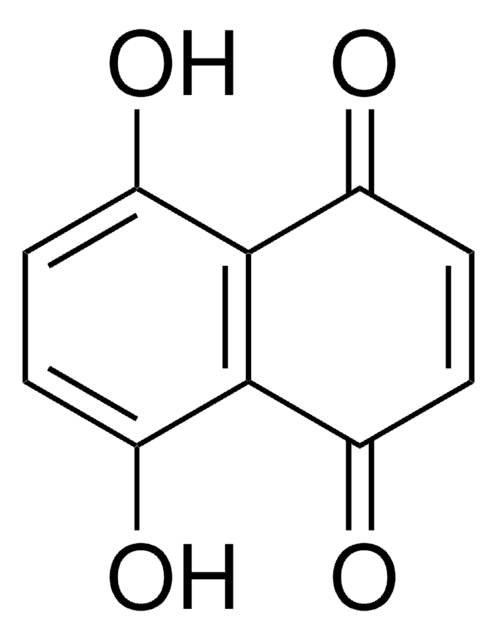420120
Juglone
A highly selective cell-permeable, irreversible inhibitor of PPlases (peptidyl-prolyl cis/trans isomerases of the parvulin family).
Synonim(y):
Juglone, 5-Hydroxy-1,4-naphthlenedione, 5-Hydroxy- p-naphthoquinone
About This Item
Polecane produkty
Poziom jakości
Próba
≥95% (HPLC)
Postać
solid
producent / nazwa handlowa
Calbiochem®
warunki przechowywania
OK to freeze
protect from light
kolor
orange
rozpuszczalność
DMSO: 10 mg/mL
ethanol: 10 mg/mL
Warunki transportu
ambient
temp. przechowywania
2-8°C
InChI
1S/C10H6O3/c11-7-4-5-9(13)10-6(7)2-1-3-8(10)12/h1-5,12H
Klucz InChI
KQPYUDDGWXQXHS-UHFFFAOYSA-N
Opis ogólny
Działania biochem./fizjol.
PPlases (peptidyl-prolyl cis/trans isomerases of the parvulin family)
Opakowanie
Ostrzeżenie
Rekonstytucja
Inne uwagi
Hennig, L., et al. 1998. Biochemistry37, 5953.
Informacje prawne
Hasło ostrzegawcze
Danger
Zwroty wskazujące rodzaj zagrożenia
Zwroty wskazujące środki ostrożności
Klasyfikacja zagrożeń
Acute Tox. 3 Oral
Kod klasy składowania
6.1C - Combustible acute toxic Cat.3 / toxic compounds or compounds which causing chronic effects
Klasa zagrożenia wodnego (WGK)
WGK 3
Certyfikaty analizy (CoA)
Poszukaj Certyfikaty analizy (CoA), wpisując numer partii/serii produktów. Numery serii i partii można znaleźć na etykiecie produktu po słowach „seria” lub „partia”.
Masz już ten produkt?
Dokumenty związane z niedawno zakupionymi produktami zostały zamieszczone w Bibliotece dokumentów.
Nasz zespół naukowców ma doświadczenie we wszystkich obszarach badań, w tym w naukach przyrodniczych, materiałoznawstwie, syntezie chemicznej, chromatografii, analityce i wielu innych dziedzinach.
Skontaktuj się z zespołem ds. pomocy technicznej








